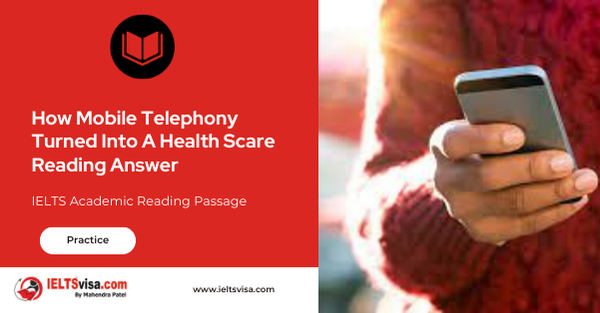How Mobile Telephony Turned Into A Health Scare Reading Answer
IELTS Academic Reading Passage
The technology which enabled mobile phones was previously used in the kind of two- way radio which could be found in taxis and emergency vehicles. Although this was a great development, it was not really considered mobile telephony because it could not be used to dial into existing phone networks. It was known as simplex technology, operating on the same principles as a walkie-talkie, which required that a user press a button, meaning that only one person at a time could talk. Simplex meant that there was only one communication frequency in use at any one time.
The first mobile phones to connect to telephone networks were often installed in cars before the hand-held version came on the market and the revolution in mobile technology began. The first generation of mobile phones (called 1G) were large, heavy and analogue and it was not until the invention of the second generation (2G) in the 1990s that digital networks could be used. The digital element enabled faster signalling. At the same time, developments in battery design and energy-saving electronics allowed the phones themselves to become smaller and therefore more truly mobile. The second generation allowed for text messaging too, and this began with the first person-to-person text message in Finland in 1993, although a machine-generated text message had been successfully sent two years earlier.
None of this would have been possible without the development of duplex technology to replace the relatively primitive simplex technology of the first phase of mobile communication. In duplex technology, there are two frequencies available simultaneously. These two frequencies can be obtained by the principle of Frequency Division Duplex (FDD). To send two signals wirelessly, it is necessary to create a paired spectrum, where one band carries the uplink (from phone to antenna) and the other carries the downlink (from antenna to phone).Time Division Duplex (TDD) can achieve the same thing, but instead of splitting the frequency, the uplink and downlink are switched very rapidly, giving the impression that one frequency is used.
For mobile telephony to work to its fullest potential, it needs to have a network through which it can relay signals.This network depends on base stations which send and receive the signals. The base stations tend to be simple constructions, or masts, on top of which are mounted the antennas. With the rapid increase in demand for mobile services, the infrastructure of antennas in the United Kingdom is now huge.
Many thousands of reports have appeared claiming that the signals relayed by these antennas are harmful to human and animal health. The claims focus on the fact that the antennas are transmitting radio waves in microwave form. In some ways, public demand is responsible for the increase in the alleged threat to health. Until quite recently, voice and text messages were transmitted using 2G technology. A 2G mast can send a low- frequency microwave signal approximately 35 kilometres.Third generation (3G) technology allows users to wirelessly download information from the internet and is extremely popular. The difference is that 3G technology uses a higher frequency to carry the signals, allowing masts to emit more radiation. This problem Is intensified by the need to have masts in closer proximity to each other and to the handsets themselves. Whatever danger there was in 2G signals is greatly multiplied by the fact that the 3G masts are physically much closer to people.
Government authorities have so far refused to accept that there is a danger to public health, and tests carried out by governments and telecommunications companies have been restricted to testing to see if heat is being produced from these microwaves. According to many, however, the problem is not heat, but electromagnetic waves which are found near the masts.
It is believed that some people, though not all, have a condition known as electro- sensitivity or electro-hypersensitivity (EHS), meaning that the electromagnetism makes them ill in some way.The actual health threat from these pulsed microwave signals is an area which greatly needs more research. It has been claimed that the signals affect all living organisms, including plants, at a cellular level and cause symptoms in people ranging from tiredness and headaches to cancer. Of particular concern is the effect that increased electromagnetic fields may have on children and the fear is that the negative effects on their health may not manifest themselves until they have had many years of continued exposure to high levels. Tests carried out on animals living close to this form of radiation are particulady useful because scientists can rule out the psychological effect that humans might be exhibiting due to their fear of possible contamination.
Of course, the danger of exposure exists when using a mobile phone but since we do this for limited periods, between which it is believed our bodies can recover, it is not considered as serious as the effect of living or working near a mast (sometimes mounted on the very building we occupy) which is transmitting electromagnetic waves 24 hours a day.
Questions 1 -6
Answer the questions below.
Write NO MORE THAN THREE WORDS for each answer.
- What were early two-way radios unable to use?
- What did you have to do in order to talk on a radio using simplex tech?
- Where were early mobile phones generally used?
- What development introduced digital technology into mobile telephony?
- Apart from the area of electronics, in which area did developments help make phones more mobile?
- What type of text message was the first one ever sent?
Questions 7-10
Complete the diagram.
Choose NO MORE THAN TWO WORDS from the passage for each answer.
Frequency Division Duplex (F) two signals sent 7…………………
Two bands together, known as a 8…………………
9………………..
10…………………
Questions 11-13
Choose the correct letter, A, B, C or D.
11 3G technology is believed to be more of a threat to health because
A the signals are transmitted over much greater distances than before.
B the masts are closer together and emit higher frequencies.
C the signals are carrying both voice and text messages.
D the modern handsets needed emit more radiation.
12 Why might the testing of animals give us more reliable results?
A because most of them live closer to the masts
B because they are continually exposed to higher levels of radiation
C because they are not affected at a cellular level
D because they are not afraid of the effects of radiation
13 What is believed to limit the danger from mobile phones?
A not using them continuously
B turning them off when not in use
C mounting a mast on the building where you live or work
D keeping healthy and getting enough sleep

Solution for: How Mobile Telephony Turned Into A Health Scare Reading Answer
| 1. (existing) phone networks | 8. paired spectrum |
| 2. press a button | 9. uplink |
| 3. (in) cars | 10. downlink |
| 4. 2G / the second generation | 11. B |
| 5. battery design | 12. D |
| 6. machine-generated | 13. A |
| 7. wirelessly |
Review and Practice
- Regularly practice with IELTS reading samples and time yourself to get used to the pressure of the exam.
- Review your mistakes to understand where you went wrong and how to avoid similar errors in the future.
Our Books
Master IELTS Speaking Part 1
IELTS Writing Task 1 Book
IELTS Writing Task 2 Book
How Mobile Telephony Turned Into A Health Scare Reading Answer Explanation
Comin Soon
Practice IELTS Other Modules
IELTS Listening
The IELTS Listening test assesses how well you can understand spoken English in various contexts. It lasts about 30 minutes and is divided into four sections with a total of 40 questions. The listening tasks become increasingly difficult as the test progresses.
IELTS Academic Reading
The IELTS Academic Reading section assesses your ability to understand and interpret a variety of texts in academic settings. It is designed to evaluate a range of reading skills, including skimming for gist, reading for main ideas, reading for detail, understanding inferences, and recognizing a writer's opinions and arguments.
IELTS Speaking
The IELTS Speaking test assesses your ability to communicate in English on everyday topics. It lasts 11-14 minutes and consists of three parts: introduction, cue card, and a discussion based on the cue card topic.
IELTS General Reading
IELTS General Reading tests your ability to understand and interpret various types of texts. Here are some key areas and types of content you can expect to encounter in the reading section, along with tips for effective preparation.
IELTS Academic Writing Task 1
In IELTS Academic Writing Task 1, you are presented with a visual representation of information, such as graphs, charts, tables, or diagrams, and you are required to summarize, compare, or explain the data in your own words.
IELTS General Writing Task 1
In IELTS General Writing Task 1, you are required to write a letter based on a given situation. The letter can be formal, semi-formal, or informal, depending on the prompt. Here’s a breakdown of the key components to include in your letter
IELTS Academic Writing Task 2
In IELTS Academic Writing Task 2, you are required to write an essay in response to a question or topic. Here’s a guide to help you understand the essential elements of this task
IELTS Exam Tips
To succeed in the IELTS exam, practice regularly, familiarize yourself with the test format, improve your vocabulary, develop time management skills, and take mock tests to build confidence.
Grammer for IELTS
Grammar is the foundation of effective communication in English. Understanding tense usage, subject-verb agreement, and sentence structure enhances clarity and coherence in writing and speaking.
Vocabulary for IELTS
Vocabulary plays a crucial role in the IELTS (International English Language Testing System) exam, especially in the Speaking and Writing sections. Here’s an overview of why vocabulary is important and how it impacts your performance
RECENT IELTS SAMPLES QUESTIONS AND ANSWERS
The Life And work Of Marie Curie Reading Answer
Marie Curie is probably the most famous woman scientist who has ever lived. Born Maria...
Becoming An Expert Reading Answer
A Expertise is commitment coupled with creativity. Specifically, it is the commitment of...
STUDY CENTRE COURSES Reading Answer
SELF-STUDY TIPS AHowever difficult you find it to arrange your time, it will pay off in the...
The Extrinct Grass In Britain Reading Answer
A The British grass interrupted brome was said to be extinct, just like the Dodo. Called...
Morse Code Reading Answer
A. A new satellite-based system is being implemented to replace Morse code for sending...
Magnetic Therapy Reading Answer
AMagnetic therapy, which is a $5-billion market worldwide, is a form of alternative medicine...













